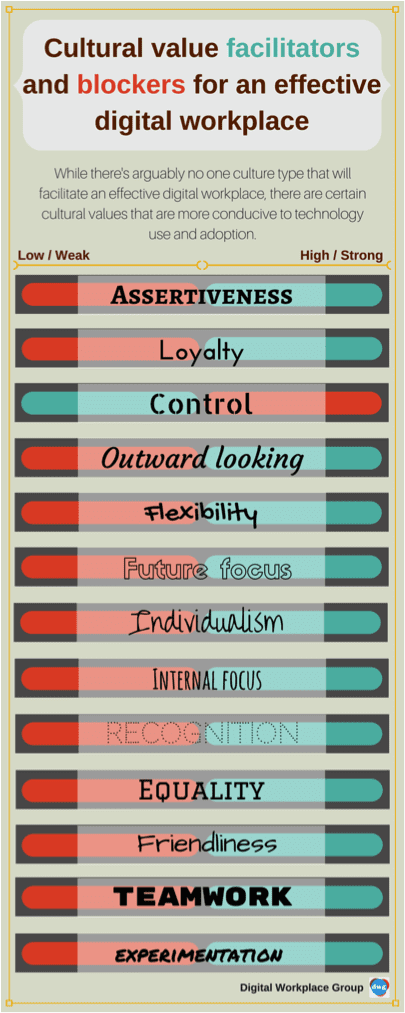Which cultural values can help and hinder an effective digital workplace programme?

In our last foray into organizational culture and the digital workplace, I brought you tales and findings from down the rabbit hole.
An increased focus on this topic had led me to tackle the question of whether there was a relationship between an organization’s culture and the effectiveness of its digital workplace initiatives. Through reading and conversations, what we initially found was that the topic – although on first consideration seemingly simple – can quickly feel like you’re sitting around the tea table with the Mad Hatter and the March Hare.
Despite being a topic that runs the risk of morphing into a perplexing mass of tunnels and stairwells, we arrived at some solid cornerstones that help lay a good foundation of understanding for this Escher-esque topic (yes, I have swapped analogies from Alice to Escher):
- Culture, at its core, is comprised of values and practices.
- The digital workplace can mirror your organization’s culture, or – as part of a wider initiative – help evolve it.
- The role of culture within any change management initiative will depend on what impact your culture is having on your attempts to achieve your vision; is it helping or hindering?
- Ultimately, you need to look into the looking glass. What is your organization’s overarching culture, if it has one? If not, what are the different cultures existing side by side? What are the pockets within that? Identify the good and the bad, so that you can plan out the right interventions to either counteract or encourage the values that are either helping or hindering your digital workplace efforts.
Dispatches from the frontline
In response to that first post, we received some anecdotal insights into what a few practitioners thought of the questions of single versus multiple cultures and the types of culture that are largely associated with an effective digital workplace:
- Values such as, “open”, “free”, “flowing information” and “collaborative” were seen as essential antecedents for a successful programme.
- One practitioner suggested that their organization has multiple personalities, making shared understanding about values and practices a constant challenge.
- The way in which digital tools “mirror”, “amplify” and “influence” culture was also touched upon. For example, even when tools such as Yammer aren’t implemented as part of a cultural change initiative, a number of organizations are finding that their take-up is creating subtle shifts in their organizational cultures.
Magnifying the detail
So, where does this leave us? Since the publication of the last post, I’ve been delving back into the academic and industry research, my notes, conversations with colleagues, and multiple spreadsheets of analysis.
 The task: to see if there are specific cultural values and practices that can be isolated as presenting either a help or a hindrance to implementing and sustaining digital ways of working.
The task: to see if there are specific cultural values and practices that can be isolated as presenting either a help or a hindrance to implementing and sustaining digital ways of working.
The good news: there are.
The “Escher” news: these same values can all too easily morph from being a help to a hindrance, and vice versa, if their presence is either too strong, too weak, or if certain circumstances allow.
In all, we identified 13 cultural values, which can contribute to either facilitating or blocking your efforts to develop and sustain an effective digital workplace. These can exist in varying degrees of strength and can also be combined, resulting in a complex array of potential different overarching cultures.
This isn’t to say that other cultural values not listed here won’t have an impact on your digital workplace programme, nor that if your organization’s culture doesn’t have these values then you may as well pack up and go home now.
Let’s pick out a couple of these in more detail. DWG members can see the extended descriptions for all 13 values in the full report.
[table id=1 /]
See the full table, along with ‘case note’ examples and references, on the member extranet.
Over to you
So, what do you think?
- Which, if any, of these values surprise you?
- Do our findings mirror your own experiences?
- How will they help you in your work? How could you use them?
We’d love to hear from you, so do drop to the comments below to join the discussion.
Escher Image source above: http://uncyclopedia.wikia.com/wiki/File:Escher%27s_Relativity.jpg
Categorised in: Digital workplace
